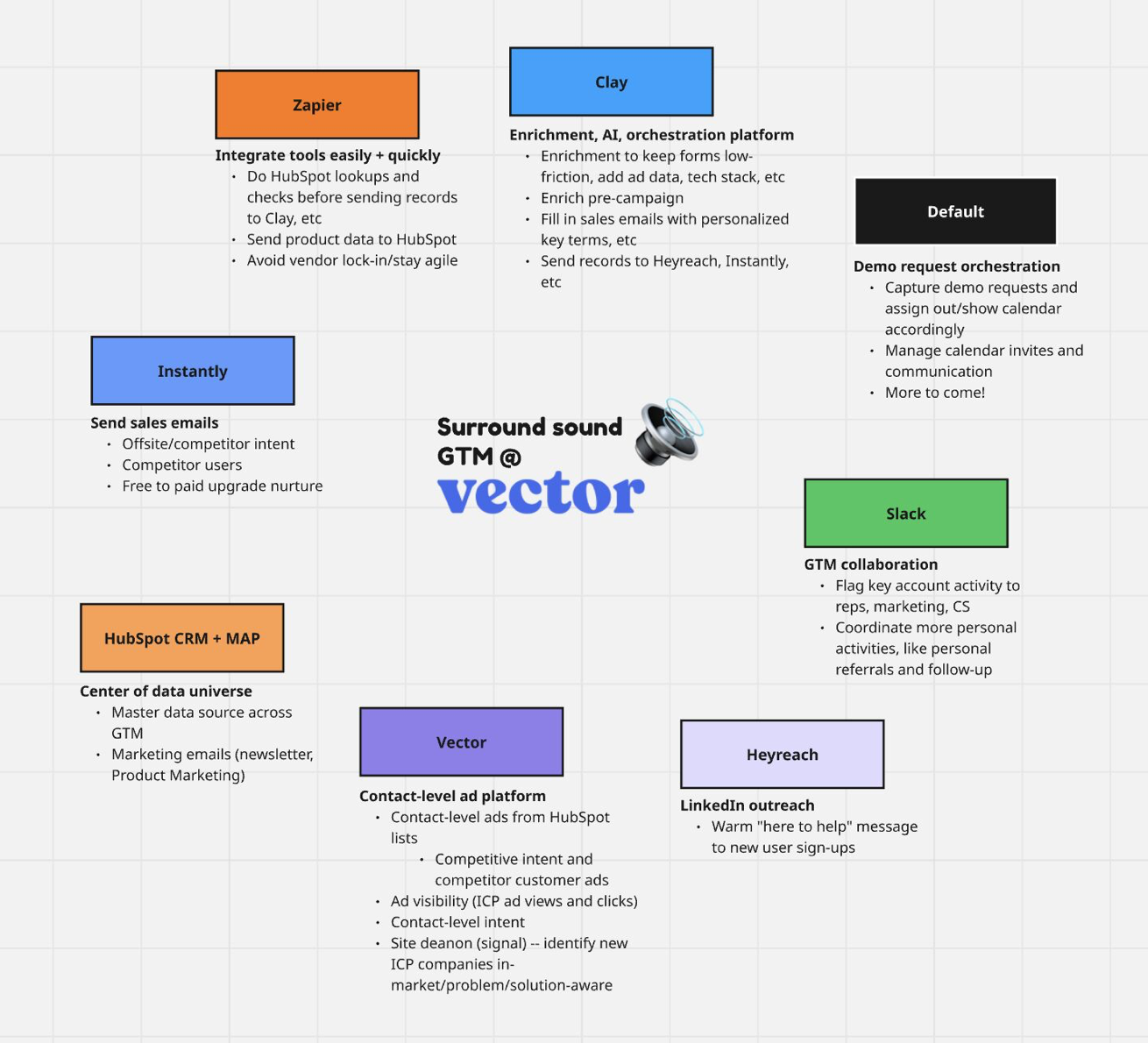How Vector runs GTM

In the Scream movies, survival comes down to following the rules. Break them, and you don’t make it to the sequel.
B2B go-to-market is no different.
The rules are different, but the stakes are the same: if you don’t orchestrate every motion across Marketing, Sales, and CS, your pipeline gets cut.

Sssshhhhhhh, don't scream. At Vector, we have a plan.
That’s where surround sound GTM comes in.
Why surround sound GTM matters
Buyers don’t move in a straight line. They bounce between ads, emails, demo requests, LinkedIn messages, and conversations with your reps.

This isn't a movie. If those touch points don’t connect, your story gets lost and so does your buyer.
Surround sound GTM is about creating one orchestrated system where:
- Ads reach the same contacts Sales is following up with.
- Demo requests are instantly captured, routed, and supported.
- Offsite intent signals trigger the right nurture plays.
- Collaboration tools like Slack keep the whole team aligned.
It’s how you turn random, disjointed interactions into a cohesive experience that builds trust and accelerates revenue.
The cast of characters

This map and the philosophy behind it came from our own MOPs powerhouse, Sara McNamara.
She keeps our stack lean, focused, and designed for scale. Or as Sara puts it designed for “no lead left behind.”

Rule #1: Don’t get locked in a vendor’s house (Zapier)
Our glue for integrations. Zapier runs HubSpot lookups before sending data into Clay, routes product data back into HubSpot, and keeps the stack agile so we don’t get trapped in one system.
Rule #2: Always know who’s behind the mask (Clay)
Clay is our enrichment + orchestration engine. It fills in tech stack, firmographics, and context, so Sales emails are personalized and campaigns start with a full picture. No more mystery buyers.
Rule #3: If the phone rings… answer (Default)
Demo requests are like creepy calls — ignore them and you’re done. Default automatically captures requests, assigns owners, and manages invites so nothing slips through the cracks.
Rule #4: Never go alone into the basement (Slack)
Slack is our collaboration layer. It flags account activity across Sales, Marketing, and CS so the team can swarm together and follow up before opportunities disappear into the dark.
Rule #5: Watch your inbox (Instantly)
This is where sales emails happen from offsite and competitor intent to free-to-paid nurture flows, Instantly turns signals into timely inbox touches.
Rule #6: The past always comes back (HubSpot CRM + MAP)
HubSpot is our system of record. It powers marketing emails, forms, and newsletters, while holding the full GTM history that always finds its way back.
Rule #7: The killer is never who you think (Vector 👻)
Accounts don’t buy — people do. Vector reveals the real contacts behind site visits, ad views, and intent signals, so you know exactly who’s lurking and ready to move.
Rule #8: There’s always a sequel (Heyreach)
Heyreach picks up the next chapter with warm LinkedIn outreach. It’s how new sign-ups get a “here to help” message that keeps the story going.
If you're a Scary Movie fan, basically this program has all your tools connected like:

Why surround sound GTM matters
In every scary movie, the victims who split up and improvise never make it to the end. GTM is the same.
When your tools don’t talk to each other, when Sales and Marketing aren’t aligned, when signals fall through the cracks — you leave buyers wandering alone in the dark.
Surround sound GTM fixes that.
It’s not about having the flashiest stack. It’s about:
- Connection: every tool playing offense and defense.
- Orchestration: ads, emails, and outbound hitting the same people at the same time.
- Precision: knowing which contacts are in-market, not just which accounts.
That’s how you create a consistent buyer experience and a pipeline that survives the horror of today’s noisy B2B market.
And the twist? Vector is what makes it possible.
Our contact-level signals fuel every other tool in the stack, so you’re not guessing who’s behind the mask, you know.
How marketers can get started

If you’re building your own surround sound GTM motion, start by asking:
- Signals: What signals do we have today (site visits, form fills, intent data)? Which ones are we missing?
- Integration: Do our tools actually talk to each other, or are we duct-taping data together?
- Precision: Are we targeting anonymous accounts, or the actual people making buying decisions?
- Coverage: Where are buyers slipping through the cracks — demo requests, free-to-paid journeys, expansion plays?
- Orchestration: Do Sales, Marketing, and CS hit the same contacts at the same time, or are we fragmented?
- Stack design: Are we keeping the stack lean and purposeful (like Sara’s map), or bloating it with tools that don’t connect?
The answers tell you where to start. From there, build your own rules and stick to them.
Final scare
Surround sound GTM isn’t about stacking flashy tools.
It’s about aligning data, timing, and messaging across the funnel so buyers feel like your company is everywhere, all at once.

Follow the rules, and you’ll survive the horror of today’s noisy B2B landscape.
Break them, and… well, let’s just say your pipeline won’t make it to the sequel.
Ad targeting
doesn't have to be
a guessing game.
Turn your contact-level insights into ready-to-run ad audiences.


